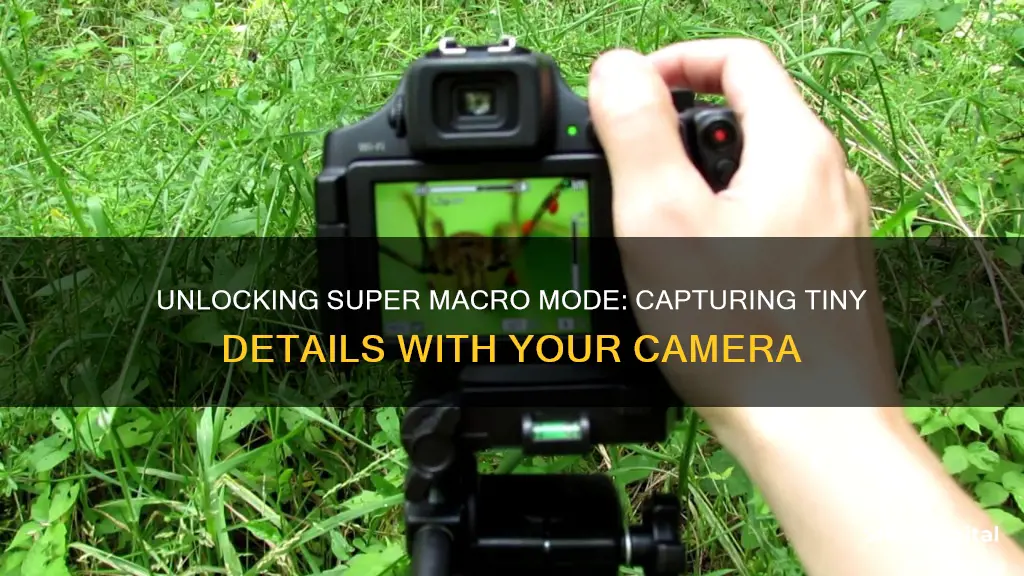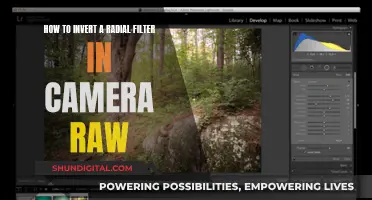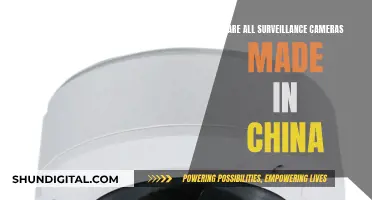
Super macro mode in cameras is an advanced version of the macro mode, which is used for extreme close-up photography. In this mode, the camera can focus on objects that are very close to the lens, allowing for incredible close-ups of tiny subjects such as insects or jewellery. The super macro mode provides an even higher level of magnification than the standard macro mode, with a ratio of 2:1 or greater, resulting in images that appear larger than life-size. This technique offers unique photographic opportunities, as the camera sensor captures details that are often invisible to the human eye.
| Characteristics | Values |
|---|---|
| Definition | Extreme close-up photography, usually of very small subjects and living organisms |
| Reproduction Ratio | The ratio of the subject size on the film plane (or sensor plane) to the actual subject size |
| Minimum Focus Distance | Cameras with super macro mode can focus on objects less than 10 cm away, with some focusing on objects just 2 cm away |
| Use Cases | Capturing the capillaries of leaves, the surface of fungus, the abdomen of a spider, and other small subjects such as insects |
What You'll Learn

Super Macro Mode allows for a closer focus than the standard Macro Mode
Super Macro Mode allows photographers to focus on objects much closer to the camera than the standard Macro Mode. This means that the ratio of the subject size on the film plane (or sensor plane) to the actual subject size is greater than 1:1.
In standard Macro Mode, the minimum focus distance is already "low enough" to allow a "usefully small" object to appear "large enough" in the image. However, Super Macro Mode allows photographers to go beyond this and capture even more extreme close-up images.
The advantage of Super Macro Mode is that it enables photographers to get incredibly close to tiny subjects, such as insects, and capture details that would not be visible to the naked eye. This results in unusual and striking photographs that showcase the minute details of everyday objects.
To achieve Super Macro images, photographers can use a combination of techniques and equipment. This includes using specific lenses, such as macro lenses or extension tubes, adjusting camera settings like aperture and shutter speed, and utilizing lighting techniques like flash diffusers.
Super Macro Mode provides photographers with the ability to explore the microscopic world and capture unique and captivating images that showcase the beauty and complexity of even the smallest subjects.
Unleashing Camera Raw's Power: From Basics to Advanced Techniques
You may want to see also

The minimum focus distance in Super Macro Mode is 2cm
Super Macro Mode in cameras allows you to take extreme close-up photographs of very small subjects, achieving a higher magnification than life size. In this mode, the minimum focus distance is 2cm, allowing you to get extremely close to your subject.
To put this into context, the minimum focus distance for standard macro lenses is typically around 15-30cm, depending on the lens and camera combination. This means that with Super Macro Mode, you can get even closer to your subject, capturing intricate details that would otherwise be impossible.
The 2cm minimum focus distance in Super Macro Mode enables you to fill the entire image frame with something very small. This results in an enormous degree of enlargement when the captured image is displayed on a screen or printed. It allows you to capture almost microscopic details, making tiny objects appear much larger than life size in your photographs.
This ultra-close focusing capability of Super Macro Mode is particularly useful for photographing small insects, flowers, and other minute objects. It provides a unique perspective that showcases the intricate beauty of these subjects.
It's important to note that achieving such a short minimum focus distance often requires additional equipment or techniques, such as specialised macro lenses, extension tubes, or reversing rings. These tools enable the camera to focus at extremely close distances, providing a unique and captivating view of the world.
Super Macro Mode empowers photographers to explore the miniature realm, revealing exquisite details that are often unseen by the naked eye.
Understanding Panoramic Photography: Pano Mode in Cameras
You may want to see also

Super Macro Mode is useful for photographing small subjects, such as insects
Super Macro Mode is a highly useful tool for photographers looking to capture small subjects, such as insects, in extreme close-up. This mode allows the camera to focus on tiny creatures and bring out intricate details that often elude the naked eye.
The main advantage of Super Macro Mode is the ability to achieve a magnification ratio greater than 1:1, which is considered the threshold for standard macro photography. A magnification ratio of 2:1 or higher is typically referred to as "super macro," and it allows photographers to fill the entire camera frame with a medium-sized insect or focus on specific parts, such as the eyes or head. This level of magnification reveals fascinating textures, intricate patterns, and complex structures that are otherwise invisible to us.
To achieve super macro images, photographers can employ various techniques and equipment. One common method is to use dedicated macro lenses, such as the Canon MP-E 65mm 1-5x or the Laowa 25mm 2.5-5x, which are specifically designed for extreme close-up photography. These lenses enable higher magnification ratios, allowing photographers to capture minute details with stunning clarity.
Another technique to achieve super macro images is to use extension tubes or bellows, which increase the distance between the lens and the camera sensor, resulting in greater magnification. While this method can be cumbersome and reduce image quality, it is a viable option for photographers on a budget. Additionally, reversing a wide-angle lens and attaching it to the front of the camera lens is a creative way to achieve super macro magnification. This method utilizes the optics of the wide-angle lens to make tiny subjects appear bigger than life-size.
Super Macro Mode also requires careful consideration of other camera settings, such as aperture and shutter speed, to ensure optimal results. A smaller aperture (higher f-number) is often necessary to achieve acceptable sharpness across the subject, as the depth of field is extremely shallow in super macro photography. Shutter speed becomes crucial when trying to capture insects in motion, with faster shutter speeds freezing movement and slower speeds intentionally creating a blur to indicate motion.
Super Macro Mode empowers photographers to explore the intricate beauty of insects and other tiny subjects, revealing a hidden world that exists beyond our normal perception. It combines technical precision with artistic creativity, resulting in captivating images that showcase the wonders of nature in a whole new light.
Displaying Filmstrip in Camera Raw: A Quick Guide
You may want to see also

It is also useful for photographing jewellery
Super macro mode in cameras allows the photographer to get even closer to the subject than is possible with a standard macro lens. This results in a ratio of 2:1 or greater, meaning the camera sensor sees closer than the human eye, leading to some unusual photography.
Super macro mode is useful for photographing jewellery because it allows the camera to get extremely close to the subject, capturing intricate details that would otherwise be impossible to see. This is especially important when photographing jewellery because it allows the photographer to showcase the fine curves, minute stones, and other intricate details that make each piece unique.
The process of photographing jewellery can be challenging due to the highly reflective nature of diamonds and coloured stones, which can appear duller in photographs than in person. Super macro mode helps to capture the brilliance and clarity of these stones by allowing for a closer perspective.
Additionally, super macro mode can be useful for photographing jewellery because it enables the photographer to focus on specific areas of the piece, such as the prongs of an engagement ring, while allowing other areas to appear softly blurred in the background. This selective focus draws the viewer's attention to the most important details of the piece.
Furthermore, super macro mode can be advantageous for jewellery photography because it allows for a shallow depth of field, creating a creamy bokeh effect that makes the jewellery stand out from the background. This technique can be particularly effective for showcasing jewellery on e-commerce websites, where clear and detailed product images are essential for building customer trust and credibility.
Overall, super macro mode in cameras is a valuable tool for photographing jewellery, as it allows for extreme close-up shots that capture the intricate beauty and unique details of each piece.
Is Your Camera Battery Charged? Check This Way
You may want to see also

Super Macro Mode is not available on all cameras
Super Macro Mode is a feature available in some smartphone cameras that allows for extreme close-up photography, often of very small subjects and living organisms. This mode is not available on all cameras because it requires specific hardware components and lens capabilities that facilitate a higher level of magnification and focus at shorter distances.
The Super Macro Mode is an advanced version of the standard Macro Mode found on many cameras. While the standard Macro Mode typically offers a 1:1 reproduction ratio, Super Macro Mode can provide a ratio of 2:1 or greater. This means that the image projected on the camera sensor is twice the size of the subject, allowing for even closer and more detailed photographs.
To achieve super macro photography, certain camera settings and equipment are required. A macro lens, preferably a prime lens, is necessary to achieve the sharpest images. Additionally, a fast lens with an f1.8 or f1.4 aperture is ideal for letting in as much light as possible. Other setups may utilize extension tubes or teleconverters to enhance the camera's macro capabilities.
It is important to note that Super Macro Mode may not be available on all smartphone models or camera brands. Manufacturers may choose to limit access to this mode or not include it at all in their devices. This could be due to hardware limitations or a decision to prioritize other features over super macro capabilities. As a result, photographers interested in super macro photography should carefully consider their camera equipment and the specific modes available to them.
While Super Macro Mode offers exciting possibilities for close-up photography, it may not be accessible to all photographers due to the required camera specifications and manufacturer restrictions.
Y Dome Camera: Battery-Powered Security Solution?
You may want to see also
Frequently asked questions
Super macro mode is an extreme close-up photography setting that allows you to capture tiny subjects, such as insects, in great detail. The image projected on the camera sensor is larger than the subject, resulting in a magnification ratio of 2:1 or greater.
Regular macro mode typically offers a 1:1 magnification ratio, meaning the image on the sensor is the same size as the subject. Super macro mode goes further, providing a closer view with a higher magnification ratio.
Super macro mode enables photographers to capture intricate details not visible to the naked eye. It's perfect for photographing small subjects like insects, flowers, or even jewellery, allowing you to showcase their textures and patterns in a unique way.
A macro lens is essential for super macro photography. Ideally, a prime lens with a fast aperture (f/1.8 or f/1.4) will provide the best results. Additionally, a tripod and flash can help with lighting and stability.
Yes, super macro photography has a very shallow depth of field, so it can be tricky to get the entire subject in focus. Lighting can also be a challenge due to the close focusing distance. Using a flash or additional lighting sources is often necessary to ensure properly exposed images.







